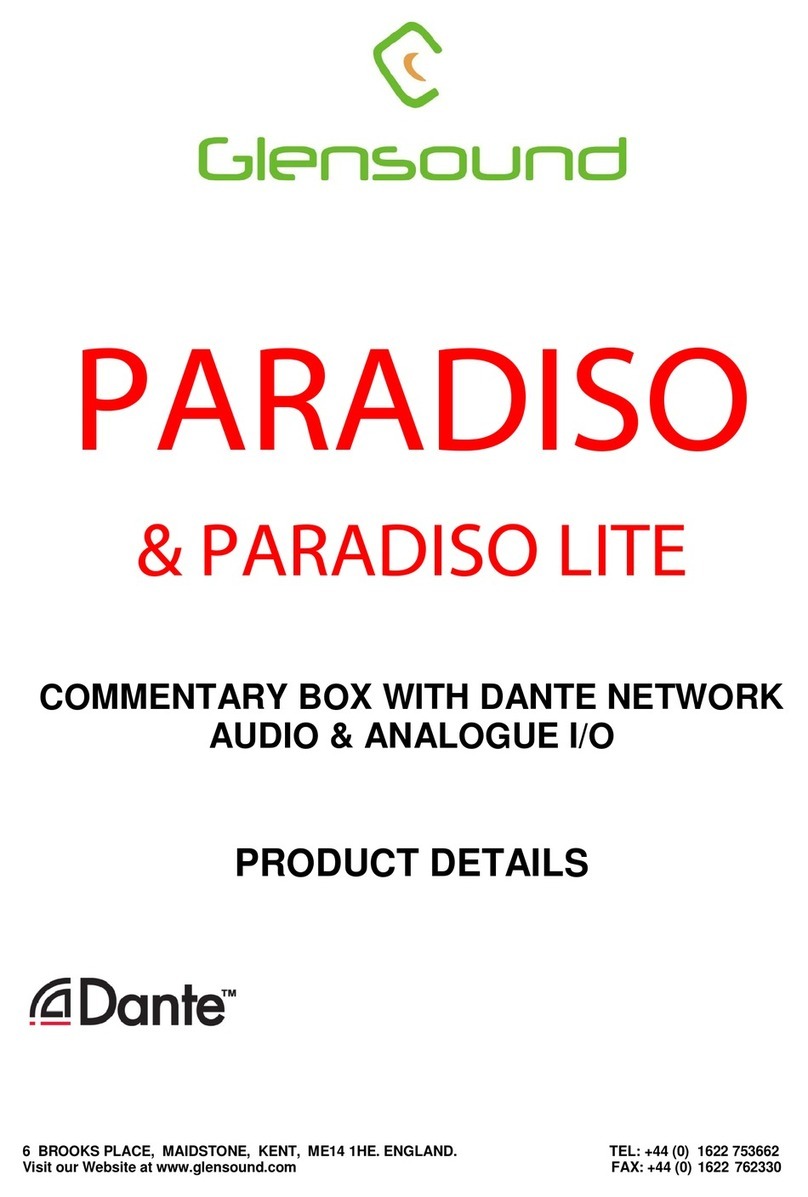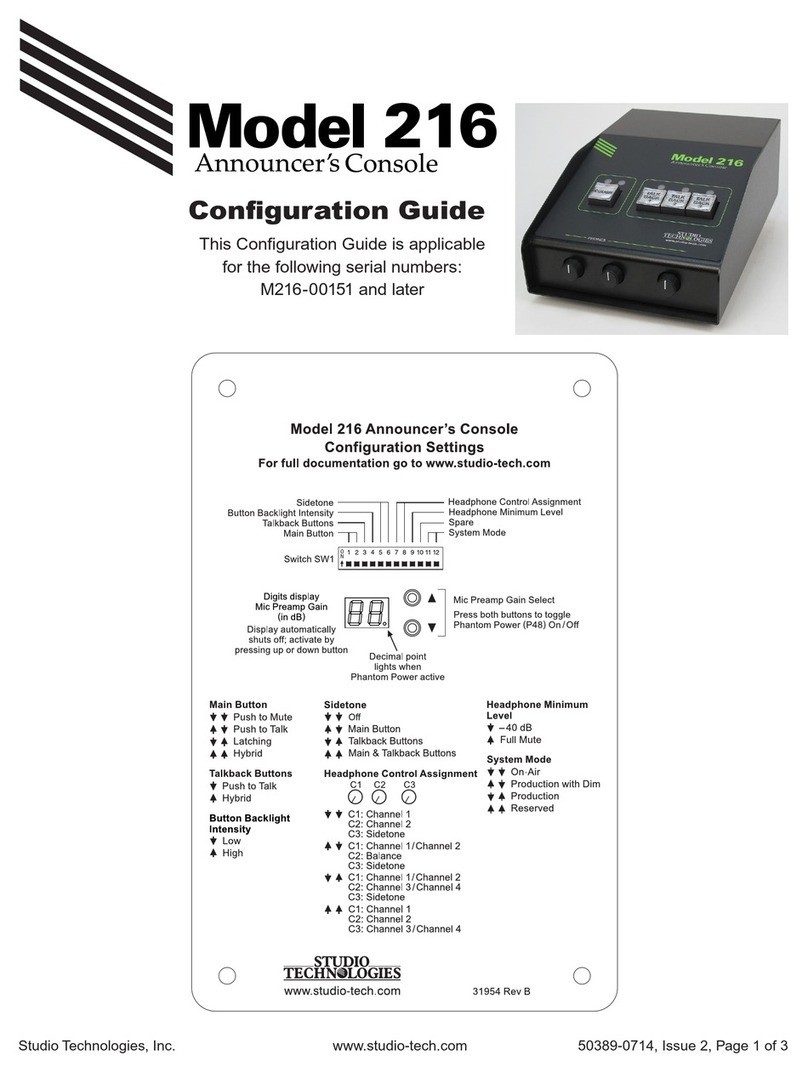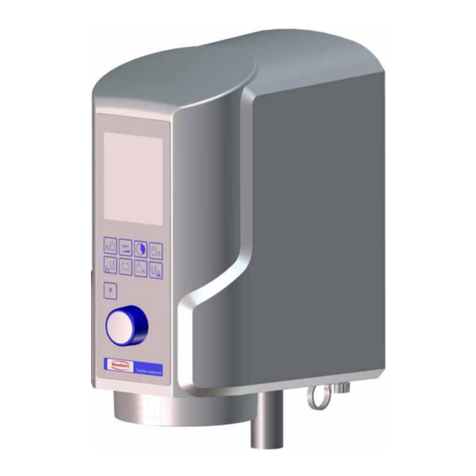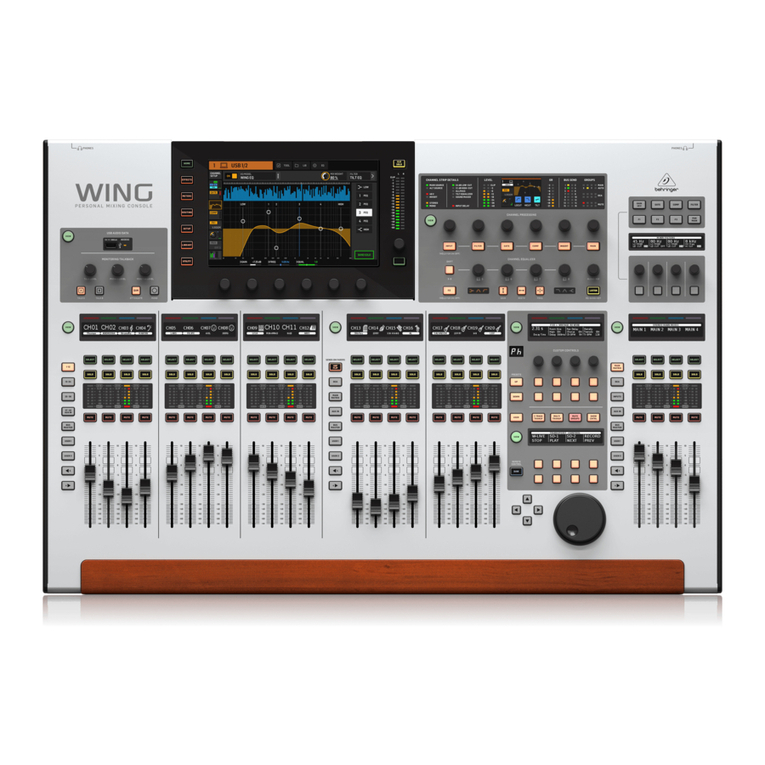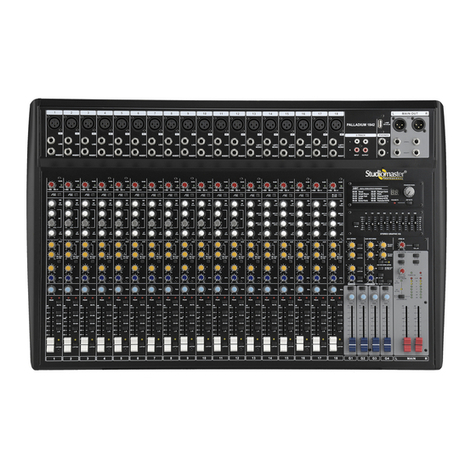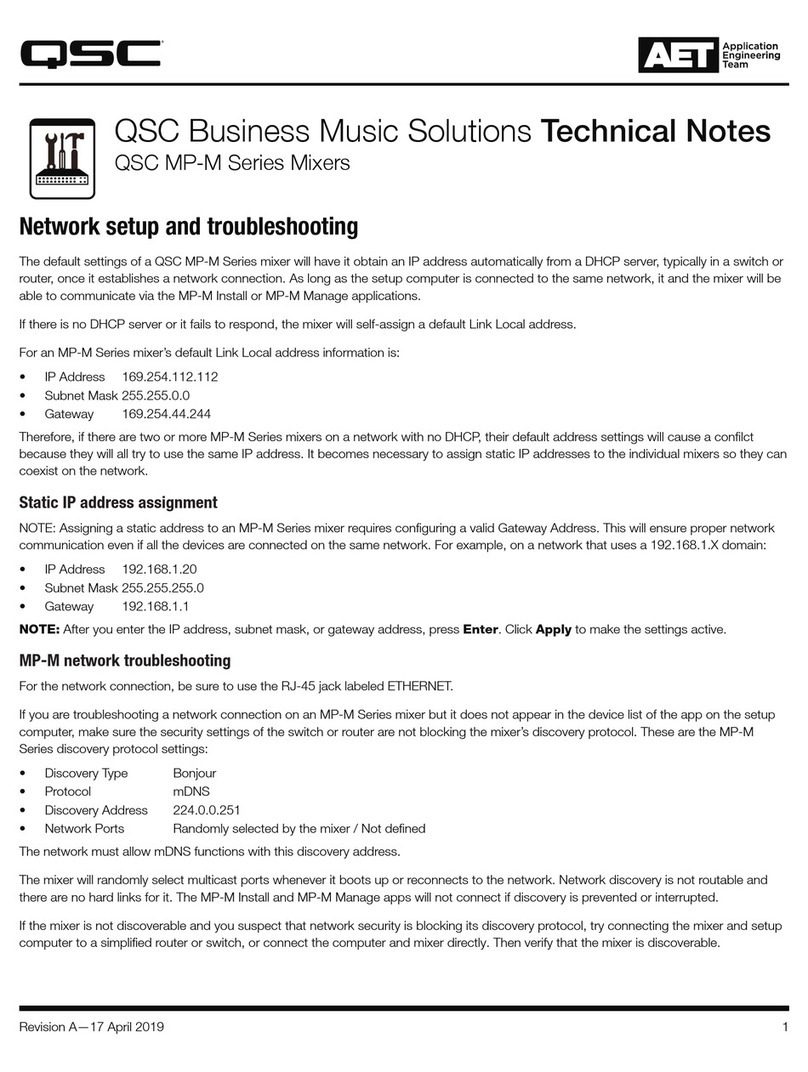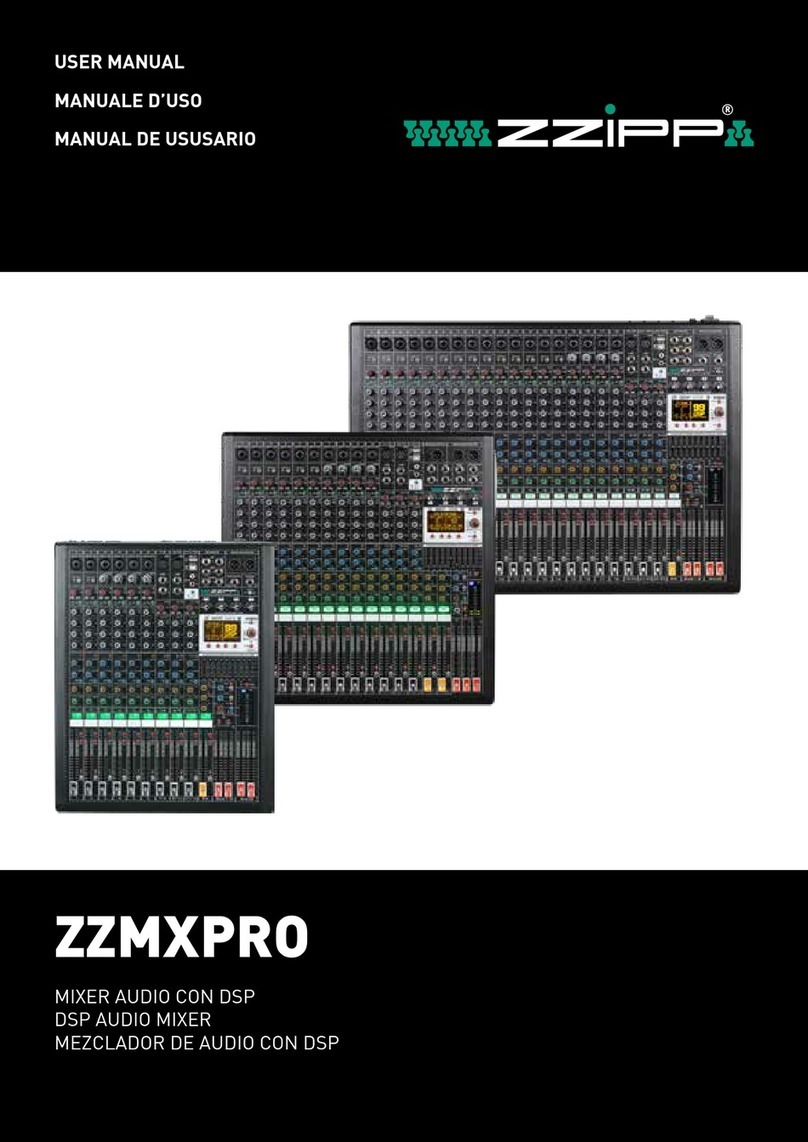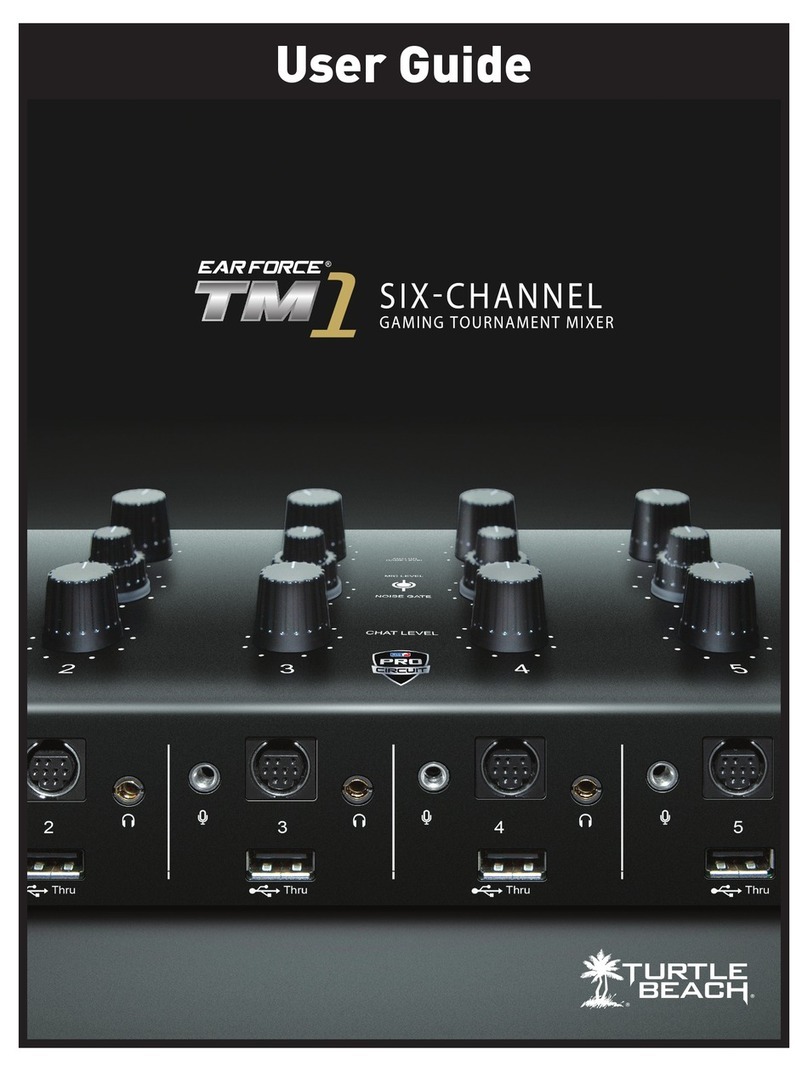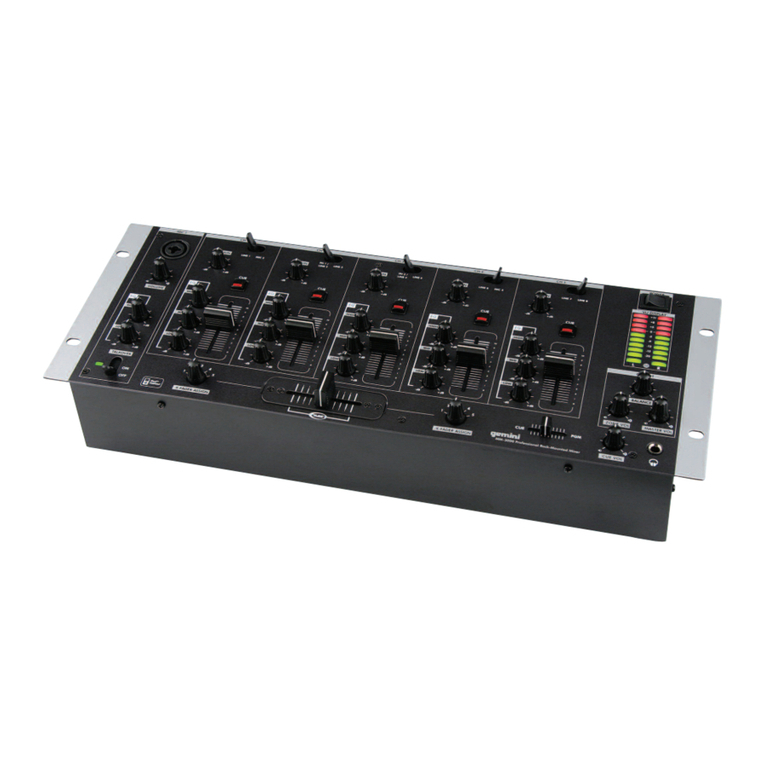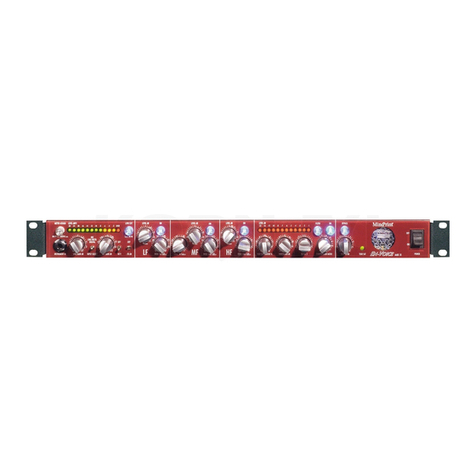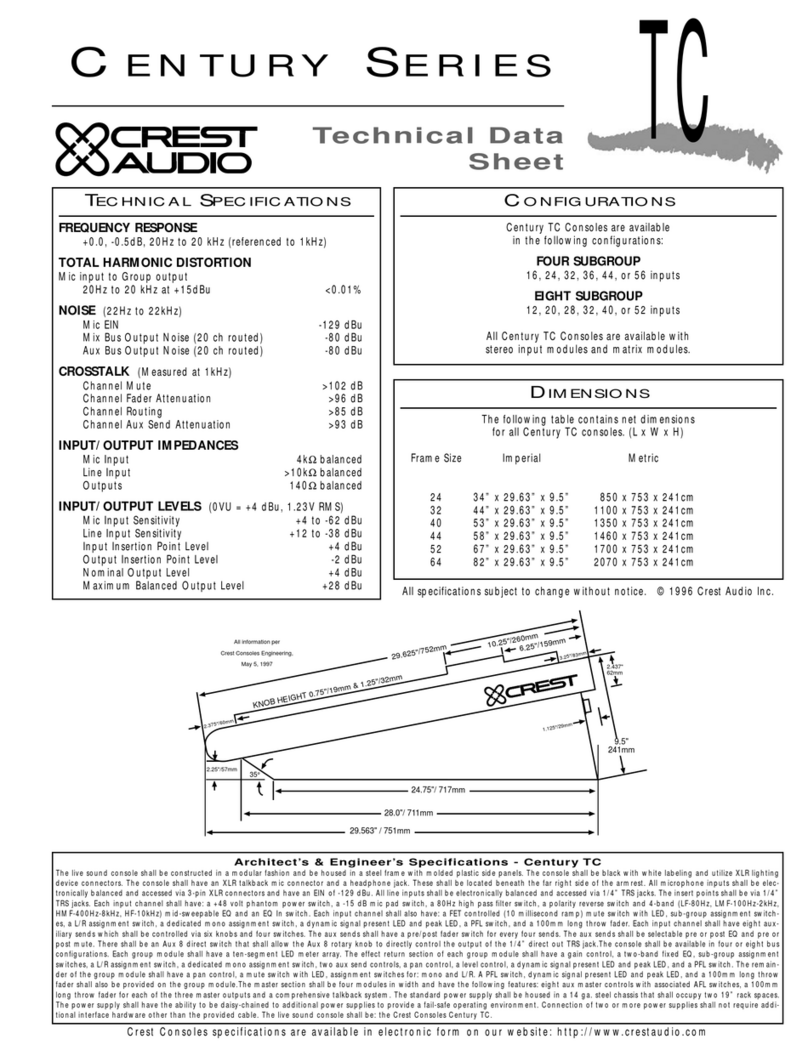Glensound GS-CU001P Installation guide

GS-CU001P
COMMENTATOR UNIT
PRODUCT DETAILS
6 BROOKS PLACE, MAIDSTONE, KENT, ME14 1HE. ENGLAND. TEL: +44 (0) 1622 753662
Vi it our Web ite at www.glen ound.co.uk FAX:
+44 (0)
1622
762330

GS-CU001P Commentator Unit
Handbook Contents
Issue 1P, June 2014
Description Drawing No.
1. GS-CU001P Overall View
2. GS-CU001P Block Diagra
3. GS-CU001P Labelled View 1 – Top Panel
4. GS-CU001P Labelled View 2 – Front and Rear Panels
5. GS-CU001P Panel Features – Explanation
6. Software Configuration
7. Circuit Diagra – Upper I/O PCB GSR30
8. Circuit Diagra – Lower I/O PCB GSR31
9. Circuit Diagra – Control Panel PCB A3-17552, 54, 56 & 58
10. Circuit Diagra – Front I/O PCB GSR33 (3 sheets)
11. Circuit Diagra – Mod. P (backup I/O & GPIO) A3-17560 & 62
12. Circuit Diagra – Mod P (PM Select) A3-17564
13. Audio detect Circuit A4-17550
14. WIRING INFORMATION

G Glensound Electronics Ltd
Thank you for choosing a new Glensound product.
All rights reserved.
Information contained in this manual is subject to change without notice if in
doubt please contact us for the latest product information.
If you need any help with the product then we can be contacted at:
Glensound Electronics Ltd
1 – 6 Brooks Place
Maidstone
Kent
ME14 1HE
United Kingdom
Telephone: +44 (0) 1622 753662
Fax: +44 (0) 1622 762330
EMAIL ADDRESSES
General enquires: of[email protected]
Technical enquires: [email protected]
Sales enquires: sales@glensound.co.uk

PRODUCT WARRANTY:
All equipment is fully tested before dispatch and carefully designed to provide
you with trouble free use for many years.
We have a policy of supporting products for as long as possible and
guarantee to be able to support your product for a minimum of 10 years.
For a period of one year after the goods have been despatched the
Company will guarantee the goods against any defect developing after proper
use providing such defects arise solely from faulty materials or workmanship
and that the Customer shall return the goods to the Company’s works or their
local dealer.
All non wear parts are guaranteed for 2 years after despatch and any defect
developing after proper use from faulty materials or workmanship will be
repaired under this warranty providing the Customer returns the goods to the
Company's works or their local dealer.

CE
This equipment manufactured by Glensound Electronics Ltd of Brooks Place
Maidstone Kent ME14 1HE is CE marked and conforms to:
Low Voltage Directive: EN60065
Emissions: EN55103.1
Immunity: EN55103.2
WASTE ELECTRICAL AND ELECTRONIC EQUIPMENT
REGULATIONS 2006 (WEEE)
Glensound Electronics Ltd is registered for business to business sales of
WEEE in the UK our registration number is:
WEE/JJ0074UR
RoHS DIRECTIVE
EC directive 2002/95/EC restricts the use of the hazardous substances listed
below in electrical and electronic equipment.
This product conforms to the above directive and for this purposes the
maximum concentration values of the restricted substances by weight in
homogenous materials are:
Lead 0.1%
Mercury 0.1%
Hexavalent Chromium 0.1%
Polybrominated Biphenyls 0.1%
Polybrominated Diphenyl
Ethers 0.1%
Cadmium 0.01%

g
+
-
LINE
MIC+PHANT
MIC
A B C
HEADPHONES HEADPHONES
+/-10dB
TRIMINPUT
MODE
COMM. GUEST GUEST
HEADPHONES
COMM.
HEADPHONES
PHANTOM POWER IS 48VOLTS HEADPHONE JACKS MAY BE A OR B GAUGEHEADPHONE IMPEDANCE 00 TO 000 OHMS
+
-
MIC+PHANT
LINE
MIC
TRIM
+/-10dB
INPUT
MODE
+
-
MIC+PHANT
LINE
MIC
TRIM
+/-10dB
INPUT
MODE
L-BOTH-R
C ON
POWER ON
L-BOTH-R
L-BOTH-R
L-BOTH-R
L-BOTH-R
L-BOTH-R
COMM A/B
H'PHONES:
H'PHONES:
H'PHONES:
H'PHONES:
H'PHONES:
H'PHONES:
PGM 1
1
3
4
5
6
PGM 2
INTERCOM 4
INTERCOM 5
INTERCOM 6
PGM 1
PGM 2
INTERCOM 4
INTERCOM 5
INTERCOM 6
H'PHONES:
L-BOTH-R
H'PHONES:
L-BOTH-R
H'PHONES:
L-BOTH-R
H'PHONES:
L-BOTH-R
H'PHONES:
L-BOTH-R
H'PHONES:
L-BOTH-R
TALK
TALK
TALK
COMM B/C
1
2
4
5
6
B ON
A ON
1 2 3 4 5 6 7
4
5
6
TALK
4
TALK
5
TALK
6
L-BOTH-R
H'PHONES:
A TBC TB
TALK
TO
A
TALK
TO
C
L-BOTH-R
H'PHONES:
SIDETONE A SIDETONE C
AUX
H'PHONES:
L-BOTH-R
3
L-BOTH-R
H'PHONES:
AUX
2
CH A
CH B
CH C
PPM SOURCE SELECT
INCOMING INTERCOM SOURCE
4 5 6
100-240V
FUSE T1AH
THIS UNIT MUST BE EARTHED.
DISCONNECT MAINS BEFORE
REMOVING COVERS.
HAZARDOUS VOLTAGES WITHIN.
WARNING
50/60Hz
-18V DC PWR I/P
PIN1=0V PIN2=+V
SERIAL NUMBER
MADE IN THE UK
CE
0dB +
-20dB
0dB
OUT
IN
COUGH
ON/OFF
FILTERS
SWITCH
MODE OUTPUTS
DIRECT
LIM
BANDPASS
AUX O/P
LOCAL
RECORD
6
INTERCOM I/P
5
INTERCOM I/P
4
INTERCOM I/P
2
PGM 2 I/P
1
PGM 1 I/P
BACKUP O/P
A
BACKUP O/P
B
BACKUP O/P
C3
AUX I/P
MAIN O/P
A
MAIN O/P
BC
MAIN O/P
INTERCOM O/P
4
INTERCOM O/P
5
INTERCOM O/P
6
GPIO
W
CE
COMMENTATOR UNIT
GS-CU001P
www.glensound.co.uk
g
MIX OUT
+
-
+
-

GAINPHANTOM
POWER
48V
BAND PASS FILTER
+/-10dB GAIN
SINGLE FRONT PANEL
ON/OFF SWITCH
COMPRESSOR ON/OFF
/OP LEVEL
CH A. LIMITED SIGNAL
TALK 3A
TALK 3C
TALK 4A
TALK 4C
TALK A
TALK C
CH A
CH C
CH B INTERCOM 3 OUT
INTERCOM 4 OUT
INTERCOM OUT
AUX OUT
LOCAL RECORD OUT
LIMITED SIGNALS
TALK TO A
TALK TO C
TO C HEADPHONE MIX
TO A HEADPHONE MIX
7 LED PPM
SOURCE SELECT
MIX OUT
CH A
CH B
CH C
PGM IN 1 & 2
TO PPM (INPUTS 1 - 3 ONLY)
CH A
HEADPHONE
CH A
HEADPHONE
GUEST
CH B
CH C
FROM TB SWITCH
CH A
SIDETONE
LIMITED SIGNALS
CH C
HEADPHONE
CH C
HEADPHONE
GUEST
CH B
CH A
FROM TB SWITCH
CH C
SIDETONE
LIMITED SIGNALS
1 OFF 3 COMMENTATORS INPUTS
TALKBACK & AUX OUTPUTS
PPM
HEADPHONE MIXES
POWER SUPPLY
GS-CU001P BLOACK DIAGRAM
3 02/06/1
A1-17168
OUT 1
OUT 2
INTERCOM IN 3 -
AUX IN
GPO FROM INTERCOM TB SWITCH 3
GPO FROM INTERCOM TB SWITCH 4
GPO FROM INTERCOM TB SWITCH
GPO FROM CH A MIC ON SWITCH
GPO FROM CH B MIC ON SWITCH
GPO FROM CH C MIC ON SWITCH
GPI
TO CH A, B & C ON SWITCHES
GPIO
COMPRESSOR/
LIMITER
GPIINTERCOM ON 3
GPIINTERCOM ON 4
GPIINTERCOM ON
OFF AIR
GPITO CH C ON SWITCH
GPITO CH B ON SWITCH
GPITO CH A ON SWITCH
g
C2014
www.glensound.co.uk
ISSUE DATE
DRAWING NUMBER

1
2
3
4
5
5c
67
5b
4a 1a
g
L-BOTH-R
C ON
POWER ON
L-BOTH-R
L-BOTH-R
L-BOTH-R
L-BOTH-R
L-BOTH-R
COMM A/B
H'PHONES:
H'PHONES:
H'PHONES:
H'PHONES:
H'PHONES:
H'PHONES:
PGM 1
1
3
4
5
6
PGM 2
INTERCOM 4
INTERCOM 5
INTERCOM 6
PGM 1
PGM 2
INTERCOM 4
INTERCOM 5
INTERCOM 6
H'PHONES:
L-BOTH-R
H'PHONES:
L-BOTH-R
H'PHONES:
L-BOTH-R
H'PHONES:
L-BOTH-R
H'PHONES:
L-BOTH-R
H'PHONES:
L-BOTH-R
TALK
TALK
TALK
COMM B/C
1
2
4
5
6
B ON
A ON
1 2 3 4 5 6 7
4
5
6
TALK
4
TALK
5
TALK
6
L-BOTH-R
H'PHONES:
A TBC TB
TALK
TO
A
TALK
TO
C
L-BOTH-R
H'PHONES:
SIDETONE A SIDETONE C
AUX
H'PHONES:
L-BOTH-R
3
L-BOTH-R
H'PHONES:
AUX
2
CH A
CH B
CH C
PPM SOURCE SELECT
INCOMING INTERCOM SOURCE
4 5 6
COMMENTATOR UNIT
GS-CU001P
www.glensound.co.uk
g
MIX OUT
+
-
+
-

8
9
11
10
12
13 14
171615
17b
1918
20 21 22
23
g
+
-
LINE
MIC+PHANT
MIC
ABC
HEADPHONES HEADPHONES
+/-10dB
TRIMINPUT
MODE
COMM. GUEST GUEST
HEADPHONES
COMM.
HEADPHONES
PHANTOM POWER IS 48VOLTS HEADPHONE JACKS MAY BE A OR B GAUGEHEADPHONE IMPEDANCE 00 TO 000 OHMS
+
-
MIC+PHANT
LINE
MIC
TRIM
+/-10dB
INPUT
MODE
+
-
MIC+PHANT
LINE
MIC
TRIM
+/-10dB
INPUT
MODE
100-240V
FUSE T1AH
THIS UNIT MUST BE EARTHED.
DISCONNECT MAINS BEFORE
REMOVING COVERS.
HAZARDOUS VOLTAGES WITHIN.
WARNING
50/60H
9-18V DC PWR I/P
PIN1=0V PIN2=+V
SERIAL NUMBER
MADE IN THE UK
CE
0dB +
-20dB
0dB
OUT
IN
COUGH
ON/OFF
FILTERS
SWITCH
MODE OUTPUTS
DIRECT
LIM
BANDPASS
AUX O/P
LOCAL
RECORD
6
INTERCOM I/P
5
INTERCOM I/P
4
INTERCOM I/P
2
PGM 2 I/P
1
PGM 1 I/P
BACKUP O/P
A
BACKUP O/P
B
BACKUP O/P
C3
AUX I/P
MAIN O/P
A
MAIN O/P
BC
MAIN O/P
INTERCOM O/P
4
INTERCOM O/P
5
INTERCOM O/P
6
GPIO
W
CE

GS-CU001P Panel Features – refer to numbered diagrams
1. Seven-segment LED bargraph meter
This has a PPM characteristic and follows the level on the AUX/ MIXED output. The scale is labelled from PPM to
7 with PPM4 equating to 0dBu at the output. Note: since the AUX/ MIXED output is always fed via the
compressor/limiter, unlimited DIRECT outputs may exceed the level displayed on the meter.
1a. PPM Source Select
The 4 LEDs indicate which source is being routed to the PPM. Pushing & releasing the small grey switch selects
the next source to the meter.
2. COMM level control (channels A an C only)
Controls the amount of signal fed from the “other” two channels into the headphone mix.
3. ON switches
The behaviour of these switches alters according to the setting of the rear panel SWITCH MODE selector. In
ON/OFF mode, brief actuation of the switches will toggle the corresponding channel on and off. In COUGH mode,
the channels remain permanently on except whilst the ON switch is held down, i.e. the switch acts as a mute.
Panel indicators display the status of each channel. When off, a channel feeds no signal to either the DIRECT or
MIXED outputs but talkback remains possible.
4. Talkback (TB) switches (channels A an C only) – see also “Switch Options” section below
Pressing any of the three talkback buttons feeds the channel signal to the correspondingly numbered talkback
output. The “smart” switches have two modes of operation – brief pushes of the switch toggle in and out of talkback
mode (“lazy” talkback), while longer pushes engage talkback only for the period that the switch is depressed
(“momentary” talkback).
Panel indicators display the status of each of the three talkback circuits. When talkback is active, the channel feeds
no signal to either the DIRECT or MIXED outputs.
Note: In many cases, the three talkback circuits will have a corresponding return talkback signal fed back to three
of the SOURCE inputs. The talkback circuits are therefore labelled 4, 5 and 6 in order to provide a loose
association with source inputs 4, 5 and 6 under these circumstances. However, the talkback send outputs are
entirely independent of the source inputs and may be used in any configuration required.
4a. Incoming Intercom Source In ication
The 3 LEDs provide a visual indication of an incoming intercom talkback circuit. The LEDs can be made to
illuminate when connected via a GPI (i.e. when connected to the output switch contact of an intercom system). The
LEDs also automatically indicate via internal audio presence circuits.
5. SOURCE level controls (channels A an C only)
Control the amount of signal fed from the correspondingly numbered/ labelled SOURCE input into the headphone
mix.
5b. A/C TB level controls (channels A an C only)
Control the amount of internal talkback signal fed from the other commentary channel into the headphone mix.

5c. SIDETONE level controls (channels A an C only)
Control the amount of each commentator’s output signal that is fed into their own headphone mix.
6. Labelling areas
Convenient areas for denoting the purpose of each SOURCE input and/or talkback circuit, using sticky labels,
chinagraph pencil etc.
7. Hea phone routing switches
Allow each of the sources contributing to the headphone mix to be fed to just the left channel, just the right channel
or both channels of the headphones as preferred.
8. IEC mains input
Accepts worldwide mains voltages without adjustment. Power consumption is less than 2W. The inlet also houses
a A slow-blow HRC fuse and in the event of failure this should be replaced with an identical part to ensure
continuing protection.
9. SWITCH MODE selector
Allows the operation of the channel ON switches to be chosen as either ON/OFF or COUGH (see above).
10. BANDPASS FILTER selector
Allows an optional bandpass filter with -3dB rolloff points of approx. 80Hz and 2.5kHz to be applied to the channel
audio signals. Note: the filter is only applied when the channel input is set to MIC or MIC+PHANT.
11. DIRECT OUTPUTS level selector
Allows one of three level options to be selected for the three DIRECT channel outputs:
The 0dB+LIM position feeds the DIRECT outputs from the internal compressor/limiter at a nominal lineup level of
0dBu. With excessive input levels automatically restricted, this is the optimal choice for simpler installations.
The 0dB position feeds the DIRECT outputs with the uncompressed input signal at a nominal lineup level of 0dBu.
This option should be selected when peak signal level is to be controlled manually or by offboard equipment.
The -20dB position feeds the DIRECT outputs with the uncompressed input signal at a nominal lineup level of -
20dBu. This option delivers maximum headroom in applications where peak signal level is to be controlled
manually or by offboard equipment.
12. LOCAL RECORD output
A 3.5mm jack socket – accepting either mono or stereo jack plugs – carrying an unbalanced signal at - 4dBu for
local recording onto MiniDisk, etc. The signal presented is a combination of the AUX/ MIXED output (i.e. the overall
output of the unit) and the signal being received on SOURCE input (e.g. return PGM cue from studio, etc.).
13. AUX/ MIXED output
A balanced mono output carrying the combined output of all three audio channels at a nominal lineup level of 0dBu.
Signals sent to the MIXED output are always processed by the compressor/limiter. The level at the MIXED output is
displayed on the front panel LED meter.

14. SOURCE inputs an link switches
Six balanced mono inputs. Source inputs contribute to the channel A and C headphone mixes via a front panel
level pot and panning switch, and may be used for cue/programme audio, talkback returns, etc.
15. DC POWER input
A four-pin male XLR via which the GS-CU00 may be powered from an external DC source lying in the range +9V
to + 8V. Power consumption is less than 2W. Should both mains and external DC power be applied, power drain
will be transferred from the mains to the DC supply once the DC voltage exceeds + 2V
.
16. TB/ INTERCOM SEND outputs
Three balanced mono outputs with a nominal lineup level of 0dBu. Channel A and C audio is fed to these outputs
when the correspondingly numbered talkback circuit is activated by the front panel buttons.
17. MAIN outputs
Three transformer balanced mono outputs, the lineup level of which is controlled by the DIRECT OUTPUTS
selector (see above). These carry the individual output signals of the three audio channels and can be used when
mixing is to be performed by off board equipment.
17b. BACKUP outputs
Three transformer balanced mono outputs. These have identical signals as the MAIN outputs and are fed from
separate output electronics & transformers and could be used for redundancy circuits.
18. COMM HEADPHONES (channels A an C only)
A stereo 6.35mm jack socket (capable of accepting both A and B gauge jack plugs) carrying the headphone mix.
Sources contributing to this mix are SOURCE inputs -5, the combined signal from the “other” two channels and
own channel sidetone. All these sources, with the exception of sidetone, have a front panel level control and
panning switch allowing customisation of the headphone mix.
19. GUEST HEADPHONES (channels A an C only)
Two stereo 6.35mm jack sockets (capable of accepting both A and B gauge jack plugs) carrying a copy of the
headphone mixes from channels A and C. A guest being interviewed may be provided with a headphone feed from
whichever channel is appropriate.
20. INPUT MODE selectors
Three position recessed switches which determine the sensitivity of the channel audio inputs. In each position the
input gain may be trimmed +/- 0dB around its nominal value (see below).
In LINE mode, the input sensitivity suits line level signals.
In MIC mode, the input sensitivity suits non-phantom powered microphones.
In MIC+PHANT mode, the input sensitivity suits phantom powered microphones and + 2V phantom power is
supplied to the input socket.
21. CHANNEL inputs
Three balanced mono audio inputs feeding the three input channels. Sensitivity is determined by the INPUT MODE
selector (see above).

22. TRIM controls
A continuous rotary control allowing the input gain to be trimmed +/- 0dB about its nominal value. In LINE mode
this may be used to accommodate both consumer and professional levels, while in MIC mode the unit may be
adapted (“on-the-fly” if necessary) to different user and microphone characteristics.
23. General Purpose Input & Output Controls (GPIO)
This 25 pin D connector provides interconnectivity to external equipment. There are 6 relay outputs and 7 loop
input circuits. The 6 relay outputs provide indication when the 3 mic circuits are on and when the 3 talkback/
intercom circuits are on. The 7 inputs provide external control of the 3 mic on circuits, a global off air control, and 3
inputs for illuminating the 3 incoming intercom source LEDs.
Switch Options
Units supplied after June 2008 are fitted with enhanced firmware that allows the operation of some front panel
controls to be altered by the user. This allows the functionality of the unit to be tailored to meet changing
requirements and fulfil different tasks. Older units can be retro fitted with this software.
Changes are made by holding down specific combinations of front panel buttons as power is applied to the unit.
For safety reasons the unit only responds to change instructions at the moment of power-up and applying the
switch combinations at any other time will have no effect other than the usual functions of the switches involved.
Combinations of switches other than those detailed below are ignored.
Only one change may be made at a time – to make multiple changes, remove power from the unit after each
change then reapply it while holding down the next switch combination required. Apart from the restrictions
described, the number of changes is unlimited and they may be applied at any time.
The unit configuration is stored in internal non-volatile memory and retained even when the unit is unpowered.
Supported options:
- Holding both C ON and TALK3-C selects normal operation of the TB switches, whereby brief depressions
of the switches toggle talkback on and off and longer presses engage talkback for only as long as the
switch is pressed. This is the default mode of operation.
- Holding both C ON and TALK4-C selects momentary-only operation of the TB switches, whereby talkback
is only engaged for as long as the switch is pressed.
- Holding both C ON and TALK5-C selects latching-only operation of the TB switches, whereby each
depression of the switch, however long or short, toggles talkback from on to off or vice versa.
- Holding both C ON and B ON toggles whether the channel A and C microphone signals are muted when
one of their corresponding talkback channels is active. The default mode of operation is for muting to be
enabled.
A Further firmware revision was made to allow the switch operation of the Talkback and Microphone circuits to be
linked together. This firmware is fitted to all versions with a serial no: 642 or higher.
- Holding both A ON and C ON allows the A & C mic switches to be linked.
- Holding both TALK3-A and TALK3-C allows the TALK3 switches to be linked.
- Holding both TALK4-A and TALK4-C allows the TALK4 switches to be linked.
- Holding both TALK5-A and TALK5-C allows the TALK5 switches to be linked.
- Holding both B ON and TALK3-A allows the B ON switch to toggle all the switches between linked switches
and normal operation. When in this mode if the B ON switch is on then any pairs of switches that have
been set to be linked will operate in the linked mode and if the B ON switch is off then these same switches
will operate individually.
- NOTE: The above programming operations 'toggle' between turning the facility on and off.

G

G

G

G

G

G

G
Table of contents
Other Glensound Music Mixer manuals


